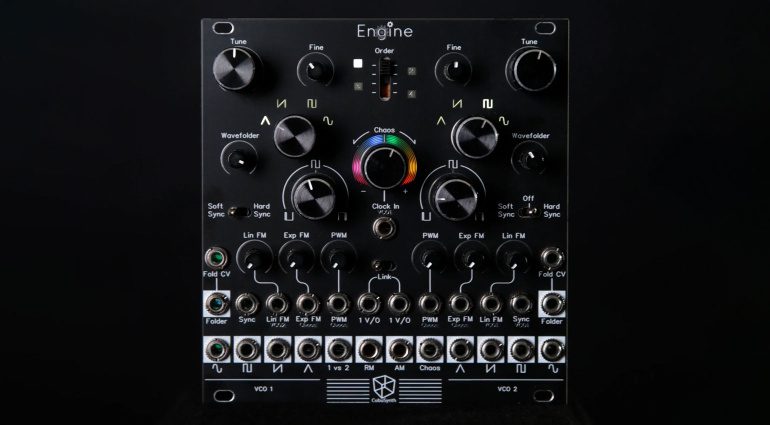CubuSynth Engine: Dual analogue VCO with chaos and wavefolding
The CubuSynth Engine places chaos at the centre of a complex, wavefolding dual cross-modulating voltage-controlled oscillator.
CubuSynth Engine
It’s an impressively dark-looking module with a delightful explosion of colour around that very intriguing Chaos knob. While Engine can be a pair of regular CEM3340-based oscillators acting on their own adventures, the real fun starts to happen once you push them into each other.
As independents, the VCOs have four waveform outputs plus a wavefolder output with its own knob and CV control. You can select which waveform you’d like to be folded on a four-way switch. There is hard and soft sync, linear and exponential FM and pulse width modulation on the square wave. So, as a regular VCO, these two have everything you need with a bit of added wavefolding spice. I really like the fact that there’s a “Link” switch above the 1v/oct inputs so you can run the two oscillators together as a 2-oscillator VCO from a single source of melody.
You are currently viewing a placeholder content from Default. To access the actual content, click the button below. Please note that doing so will share data with third-party providers.
Chaos
Once you are ready to make things a bit more complex, the Chaos engine can dial in some semi-random, shift register voltages to the PWM and exponential FM. The signals are clocked from VCO1 and based on VCO2, so they are nicely interconnected. These can also be clocked externally to keep the modulations rhythmic and relevant to the rest of your patch. On “Order” switch in the middle sets the influence of the Chaos from gentle to extreme with the big knob setting the range.
With the Chaos engine infecting the internal modulations, other FM and complex routings are encouraged via patch cables rather than normalisation.
Meanwhile, complex modulations are emerging from various combinations of signal interaction. There’s a 1vs2 comparator output that outputs a pulse whenever VCO2 is higher than VCO1. There’s a Ring Modulation output based on an XOR gate. Amplitude modulation is produced by VCO1 messing with VCO2. And you can take the Chaos out onto other things.
Not so complex
I expected Engine to push heavily into the complex sound generation that characterises so many dual VCO modules. But it actually has a different and, for me, very pleasing approach. The focus is on introducing randomisation to moments of PWM and FM rather than overwhelming you with complex waveforms. Don’t get me wrong, complexity is all there for the patching, but Engine feels much more open to nuance, choice and versatility.
Engine is available as a kit from €55-€199 and as a fully built module for €399.
- CubuSynth website.
You are currently viewing a placeholder content from YouTube. To access the actual content, click the button below. Please note that doing so will share data with third-party providers.

 4,3 / 5,0 |
4,3 / 5,0 | 






